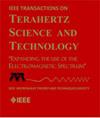100 Gbit/s and Beyond IEEE 802.15.3d Channelization Compatible THz Communications Enabled by a Broadband MUTC Photodiode
IF 3.9
2区 工程技术
Q2 ENGINEERING, ELECTRICAL & ELECTRONIC
IEEE Transactions on Terahertz Science and Technology
Pub Date : 2025-02-13
DOI:10.1109/TTHZ.2025.3541824
引用次数: 0
Abstract
We present photonics-driven high data rate IEEE 802.15.3d compliant terahertz (THz) communication links operated at a center frequency of 280 GHz. We analyze wireless data transmission within selected single and dual channels of the IEEE 802.15.3d and assess the outcomes through additional back-to-back (B2B) data transmission measurements and calibrated link budgets of the THz link. The system architecture uses on-wafer probing of a single high-power and highly linear broadband modified unitraveling-carrier photodiode (MUTC-PD). Using the MUTC-PD as THz transmitter, we report 16-QAM 100 Gbit/s 25-cm wireless links for single and dual channel data transmission with significantly low error vector magnitude (EVM) levels, that is, 12.3% and 10.9%, respectively. As for B2B demonstration, we successfully transmit 200 Gbit/s (32-QAM) in a single channel with 7.5% EVM and 160 Gbit/s (16-QAM) in dual channel with 7.8% EVM. We further display the highly linear nature of the MUTC-PD by efficient data transmission with higher modulation formats, which is also supported by the power-saturation characteristics of the PD. To the best of the authors´ knowledge, this is the first study investigating the IEEE 802.15.3d channelization compliancy through system level design and spectral verification while at the same time achieving 100 Gbit/s and beyond data rates with notably low EVM values.100gbit /s及以上的IEEE 802.15.3d信道化兼容太赫兹通信,由宽带MUTC光电二极管实现
我们提出了光电驱动的高数据速率IEEE 802.15.3d兼容太赫兹(THz)通信链路,其中心频率为280 GHz。我们分析了IEEE 802.15.3 3d中选定的单通道和双通道中的无线数据传输,并通过额外的背靠背(B2B)数据传输测量和校准太赫兹链路的链路预算来评估结果。该系统架构采用单颗高功率、高线性宽带修改单载波光电二极管(MUTC-PD)的晶上探测。使用MUTC-PD作为太赫兹发射机,我们报告了用于单通道和双通道数据传输的16-QAM 100 Gbit/s 25 cm无线链路,其误差矢量幅度(EVM)水平显著降低,分别为12.3%和10.9%。在B2B演示中,我们成功地在单通道传输200 Gbit/s (32-QAM), EVM为7.5%,在双通道传输160 Gbit/s (16-QAM), EVM为7.8%。我们通过更高调制格式的高效数据传输进一步展示了MUTC-PD的高度线性特性,这也得到了PD的功率饱和特性的支持。据作者所知,这是第一个通过系统级设计和频谱验证来调查IEEE 802.15.3d信道化遵从性的研究,同时实现100 Gbit/s及以上的数据速率,EVM值非常低。
本文章由计算机程序翻译,如有差异,请以英文原文为准。
求助全文
约1分钟内获得全文
求助全文
来源期刊

IEEE Transactions on Terahertz Science and Technology
ENGINEERING, ELECTRICAL & ELECTRONIC-OPTICS
CiteScore
7.10
自引率
9.40%
发文量
102
期刊介绍:
IEEE Transactions on Terahertz Science and Technology focuses on original research on Terahertz theory, techniques, and applications as they relate to components, devices, circuits, and systems involving the generation, transmission, and detection of Terahertz waves.
 求助内容:
求助内容: 应助结果提醒方式:
应助结果提醒方式:


